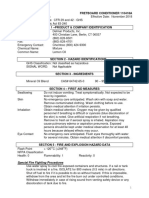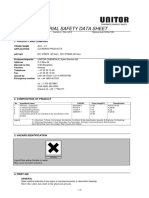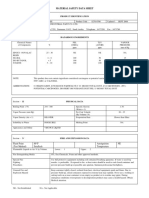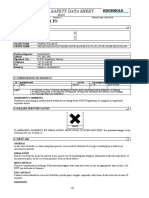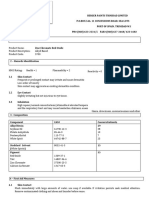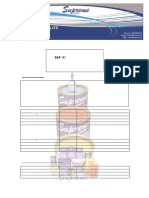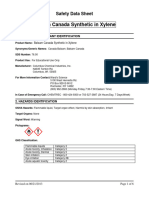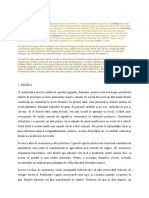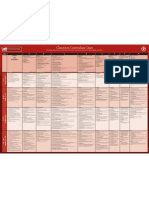A-Typical Composition B-Physiological Effects and Health Information
A-Typical Composition B-Physiological Effects and Health Information
Uploaded by
slamet4riadiCopyright:
Available Formats
A-Typical Composition B-Physiological Effects and Health Information
A-Typical Composition B-Physiological Effects and Health Information
Uploaded by
slamet4riadiOriginal Description:
Original Title
Copyright
Available Formats
Share this document
Did you find this document useful?
Is this content inappropriate?
Copyright:
Available Formats
A-Typical Composition B-Physiological Effects and Health Information
A-Typical Composition B-Physiological Effects and Health Information
Uploaded by
slamet4riadiCopyright:
Available Formats
Warning Statement Name
DANGER! EXTREMELY FLAMMABLE
ACETYLENE
C2H2
A-Typical Composition
Acetylene 100%
B-Physiological Effects and Health Information
Exposure No OSHA exposure standard or Threshold Limit Value has been established
Standard for this material.
Eye This material is not expected to cause eye irritation. (See note below)
Irritation
Skin This material is not expected to cause skin irritation. (See note below)
Irritation
Systemic Acetylene is classified as a simple asphyxiant. High concentrations in air
Effects may
produce asphyxia by contributing to oxygen deficiency. Signs and
symptoms
which precede asphyxia may include rapid respiration, loss of mental
alertness
and coordination, dizziness, nausea and vomiting. Continued exposure
may result
in prostration, convulsions, coma, and death.
Note : The data and conclusions given here are from the supplier and the
scientific literature.
C-Emergency and First Aid Procedures
Eye This material is not expected to be irritating to the eyes.
Contact
Skin This material is not expected to be irritating to the skin.
Contact
Inhalation If there are signs or symptoms of overexposure to this material (ad described in
Section B-Systemic Effects), move the individual to an uncontaminated area.
If breathing has stopped, apply artificial respiration and get medical attention.
Ingestion
D-Special Protection Information
Eye
Protection
Respiratory
Protection
Skin
Protection
Ventilation
Other
E-Fire Protection Information
Flash Point Flammable Limits Lower limit
(test method) (by volume in air) 2.5% upper limit 81%
Autoignition Extinguishing
Temperature 635F Media Stop gas flow. Water Spray may be used for
cooling.
Special For fires involving this material, do not enter any enclosed or confines fire space
Fire Fighting without proper protective equipment. This may include self-contained breathing
Procedures apparatus to protect against the hazardous effects of normal products of
combustion or oxygen deficiency.
F-Reactivity Data
Stability Stable Condition
Pure acetylene may explode at pressure
s in
(thermal, light, etc.) Unstable X to Avoidexcess of 15 psig. Or when shocked. (See
Note in Section H-Special Precautions.)
Incompatibility May react explosively with oxidizing agents. May form explosive
(material to avoid) compounds with copper, mercury, silver or their salts, and with
potassium and nitric acid.
Hazardous Normal combustion forms carbon dioxide and water vapor; incomplete
Decomposition Products combustion can produce carbon monoxide.
Hazardous May Occur X Condition
s
Polymerization Will not Occur to Avoid
G-Environmental Protection
Environmental
Impact
Precaution if Material Eliminate all sources of ignition in vicinity of released gas. Stop gas flow.
is Released or Spilled
Waste Disposal
Methods
H-Special Precautions
Handling and READ AND OBSERVE PRECAUTIONS ON PRODUCT LABEL
Storing Store in plainly-marked, tightly-closed containers
in a cool location.
Note : Commercial cylinders contain acetone to dissolve and reduce the
pressure and reactivity of acetylene
I-Physical Properties
Boiling Point -130F Melting Point -116F Solubility
@ 10 psig. @ 10 psig. Soluble in acetone, benzene,
chloroform and many organic
solvents; slightly soluble in
water and alcohol.
Vapor Pressure 1520 mm Hg Specific Gravity Appearance, Color, Odor, etc.
(mm Hg & @ - 97F (H2O = 1) Colorless gas with a garlic-
temp) like odor.
Molecular 26 Percent Volatile 100% Viscosity
Weight by Volume (%)
Vapor Density 0.91 Evaporation
(air = 1) ( = 1)
Pour Point Other
You might also like
- Unitor MsdsDocument5 pagesUnitor Msdsvakil50% (2)
- Asd Tug 3212 FactsheetDocument1 pageAsd Tug 3212 FactsheetRoda NiagaNo ratings yet
- Material Safety Data Sheet: SeacleanDocument6 pagesMaterial Safety Data Sheet: SeacleanJezrell JaravataNo ratings yet
- Introduction To PlumbingDocument18 pagesIntroduction To PlumbingJerico Ancheta86% (7)
- 1,1,1,2 - Tetrafluoroethane. (R134a) : Material Safety Data Sheet (MSDS)Document3 pages1,1,1,2 - Tetrafluoroethane. (R134a) : Material Safety Data Sheet (MSDS)Syed FirozNo ratings yet
- N-Ver-Sperse o With XyleneDocument6 pagesN-Ver-Sperse o With XyleneU.s. Ezhil ArivudainambiNo ratings yet
- Material Safety Data Sheet: Product IdentificationDocument4 pagesMaterial Safety Data Sheet: Product Identificationمحمد عزتNo ratings yet
- Oxygen MSDS-Bristol GasesDocument5 pagesOxygen MSDS-Bristol GasesAhmad Talaat100% (1)
- Material Safety Data Sheet: N-Ver-Sperse ODocument6 pagesMaterial Safety Data Sheet: N-Ver-Sperse OU.s. Ezhil ArivudainambiNo ratings yet
- Material Safety Data Sheet Nafs Iii: Dangerous Goods. Non Hazardous SubstanceDocument2 pagesMaterial Safety Data Sheet Nafs Iii: Dangerous Goods. Non Hazardous SubstanceicsNo ratings yet
- Co AsgDocument5 pagesCo AsgMurugaraj SelvarajNo ratings yet
- SDS - 110418A Fretboard Conditioner Oil 11-14-18Document5 pagesSDS - 110418A Fretboard Conditioner Oil 11-14-18Rafael FrançaNo ratings yet
- MSDS - AcetyleneDocument5 pagesMSDS - AcetyleneNishanthNJNo ratings yet
- NORPOLR Gelcoat GD 11030 S EX3 (MSDS)Document5 pagesNORPOLR Gelcoat GD 11030 S EX3 (MSDS)Shahzaib KhanNo ratings yet
- Material Safety Data Sheet: Product IdentificationDocument4 pagesMaterial Safety Data Sheet: Product Identificationمحمد عزتNo ratings yet
- Material Safety Data Sheet: AcetyleneDocument1 pageMaterial Safety Data Sheet: AcetyleneNuri Estiana AnggrainiNo ratings yet
- MSDS Syntal HG 4230102Document2 pagesMSDS Syntal HG 4230102محمد عزتNo ratings yet
- Msds-Thinnal 4280101Document2 pagesMsds-Thinnal 4280101محمد عزتNo ratings yet
- Material Safety Data Sheet: U066 1. Identification of The Substance/Preparation and of The Company/UndertakingDocument5 pagesMaterial Safety Data Sheet: U066 1. Identification of The Substance/Preparation and of The Company/UndertakingPranav DubeyNo ratings yet
- MATERIAL SAFETY Ava - PhpagunkDocument4 pagesMATERIAL SAFETY Ava - Phpagunkfs1640No ratings yet
- Methanol DatasheetDocument3 pagesMethanol DatasheetJeevanNo ratings yet
- Material Safety Data Sheet: Product IdentificationDocument4 pagesMaterial Safety Data Sheet: Product Identificationمحمد عزتNo ratings yet
- Safety Precuation of Tin Octate, N HexanolDocument3 pagesSafety Precuation of Tin Octate, N Hexanolkakaimraan025No ratings yet
- ANSUL Inergen MSDS Sheet PDFDocument5 pagesANSUL Inergen MSDS Sheet PDFAlvaro Rojas AnzolaNo ratings yet
- Acetylene MSDS PDFDocument7 pagesAcetylene MSDS PDFiqbalhanif21No ratings yet
- Material Safety Data Sheet: TankleenDocument6 pagesMaterial Safety Data Sheet: TankleenJezrell JaravataNo ratings yet
- Material Safety Data Sheet: Carbonclean LTDocument5 pagesMaterial Safety Data Sheet: Carbonclean LTJezrell JaravataNo ratings yet
- Material Safety Data Sheet: TM TMDocument6 pagesMaterial Safety Data Sheet: TM TMAris WicaksonoNo ratings yet
- Material Safety Data Sheet: Penetron PlusDocument6 pagesMaterial Safety Data Sheet: Penetron PlusJezrell JaravataNo ratings yet
- Material Safety Data Sheet: Acc - LTDocument5 pagesMaterial Safety Data Sheet: Acc - LTJezrell JaravataNo ratings yet
- Pro Catalyst - Material Safety Data SheetDocument3 pagesPro Catalyst - Material Safety Data SheetPanya PurahongNo ratings yet
- Material Safety Data Sheet: Coldwash HDDocument6 pagesMaterial Safety Data Sheet: Coldwash HDJezrell JaravataNo ratings yet
- Msds of ChlorineDocument3 pagesMsds of ChlorineRahul ParmarNo ratings yet
- Material Safety Data Sheet: Tankleen PlusDocument5 pagesMaterial Safety Data Sheet: Tankleen PlusJezrell JaravataNo ratings yet
- Material Safety Data Sheet: 1. Chemical Product and Company IdentificationDocument3 pagesMaterial Safety Data Sheet: 1. Chemical Product and Company IdentificationvtpsNo ratings yet
- Losurf-300 Nonionic SurfactantDocument6 pagesLosurf-300 Nonionic SurfactantBoualam BouNo ratings yet
- Cat Sulphite L (CSL)Document5 pagesCat Sulphite L (CSL)Jezrell JaravataNo ratings yet
- Acetylene MSDSDocument6 pagesAcetylene MSDSEmgr. Muhammad FahdNo ratings yet
- Material Safety Data Sheet: Product IdentificationDocument4 pagesMaterial Safety Data Sheet: Product Identificationمحمد عزتNo ratings yet
- Norpol FI - Vinylester Paste SafetySheetDocument6 pagesNorpol FI - Vinylester Paste SafetySheetJohn JairoNo ratings yet
- Ethyl Alcohol, 70%, in Water: Safety Data SheetDocument6 pagesEthyl Alcohol, 70%, in Water: Safety Data SheetAmalia Desy SaputriNo ratings yet
- Material Safety Data Sheet: Air Cooler CleanerDocument6 pagesMaterial Safety Data Sheet: Air Cooler CleanerJezrell JaravataNo ratings yet
- Berger Zinc Chromate Red Oxide Msds - T&T - 9259Document5 pagesBerger Zinc Chromate Red Oxide Msds - T&T - 9259Darshak SonaraNo ratings yet
- Citadel Diamond Wrap Standard Primer ResinDocument5 pagesCitadel Diamond Wrap Standard Primer ResinPeter RodriguezNo ratings yet
- Material Safety Data Sheet: Seacare EcosperseDocument5 pagesMaterial Safety Data Sheet: Seacare EcosperseJezrell JaravataNo ratings yet
- Material Safety Data SheetDocument2 pagesMaterial Safety Data Sheetمحمد عزتNo ratings yet
- Ipa MsdsDocument4 pagesIpa Msdsapi-369738022No ratings yet
- A Thinners Specification and Safety Data SheetDocument6 pagesA Thinners Specification and Safety Data Sheetfrancois de langeNo ratings yet
- 6640 MSDSDocument4 pages6640 MSDSShaikhRizwanNo ratings yet
- Mould ExDocument5 pagesMould ExProsenjit76No ratings yet
- Msds For Oxygen (Compressed)Document3 pagesMsds For Oxygen (Compressed)Darius DsouzaNo ratings yet
- AR118 - MSDS 2023 (Chemlube) - 19.10.2023Document8 pagesAR118 - MSDS 2023 (Chemlube) - 19.10.2023sanichi135No ratings yet
- MSDS-Calcium Hypo HI 70Document5 pagesMSDS-Calcium Hypo HI 70lokeshNo ratings yet
- Ethanol Ahyd Histo 4lDocument10 pagesEthanol Ahyd Histo 4ls231471913No ratings yet
- Acetone MsdsDocument4 pagesAcetone Msdsapi-369738022No ratings yet
- Balsam CanadaDocument6 pagesBalsam CanadaDewa alamsyahNo ratings yet
- MSDS 134DFVHGDocument8 pagesMSDS 134DFVHGmynameismiakNo ratings yet
- Material Safety Data Sheet: HP WashDocument5 pagesMaterial Safety Data Sheet: HP WashJezrell JaravataNo ratings yet
- DiaQueen SUPER LONG LIFE COOLANT PREMIUM PDFDocument5 pagesDiaQueen SUPER LONG LIFE COOLANT PREMIUM PDFJohannes VGNo ratings yet
- A261-Schlumberger Corrosion Inhibitor A261Document6 pagesA261-Schlumberger Corrosion Inhibitor A261Lab. Petroleo AGENANo ratings yet
- Kontraktor Akan Mengikutsertakan Semua Karyawan Untuk Dapat Mengikuti Pelatihan-Pelatihan Selama Bekerja Di PT - IRSINDO PRATAMA, AdalahDocument3 pagesKontraktor Akan Mengikutsertakan Semua Karyawan Untuk Dapat Mengikuti Pelatihan-Pelatihan Selama Bekerja Di PT - IRSINDO PRATAMA, Adalahslamet4riadiNo ratings yet
- Training Matrix NewDocument2 pagesTraining Matrix Newslamet4riadiNo ratings yet
- Hazard Identification 2-2-10Document1 pageHazard Identification 2-2-10slamet4riadiNo ratings yet
- Hazard Identification 4-2-10Document1 pageHazard Identification 4-2-10slamet4riadiNo ratings yet
- Hazard Identification 3-2-10Document1 pageHazard Identification 3-2-10slamet4riadiNo ratings yet
- Ppe SizeDocument4 pagesPpe Sizeslamet4riadiNo ratings yet
- Hazard Identification 3-2-10aDocument1 pageHazard Identification 3-2-10aslamet4riadiNo ratings yet
- UniformDocument24 pagesUniformslamet4riadiNo ratings yet
- Walk Thru FindingDocument18 pagesWalk Thru Findingslamet4riadiNo ratings yet
- Mini Bus C 001 RW 12 Rev.1Document2 pagesMini Bus C 001 RW 12 Rev.1slamet4riadi100% (1)
- Monthly Crane Inspection ChecklistDocument2 pagesMonthly Crane Inspection Checklistslamet4riadiNo ratings yet
- Book 1Document4 pagesBook 1slamet4riadiNo ratings yet
- C 035 RW Vibrator12 Rev.1Document1 pageC 035 RW Vibrator12 Rev.1slamet4riadiNo ratings yet
- Interim Review FormDocument11 pagesInterim Review Formslamet4riadiNo ratings yet
- KM DeliverDocument26 pagesKM Deliverslamet4riadiNo ratings yet
- FSWP PBDocument175 pagesFSWP PBslamet4riadiNo ratings yet
- PB Site Insp Form HOOUDocument4 pagesPB Site Insp Form HOOUslamet4riadiNo ratings yet
- Material Safety Data Sheet: Gear Oli SaeDocument1 pageMaterial Safety Data Sheet: Gear Oli Saeslamet4riadiNo ratings yet
- PB Waste Management FormDocument3 pagesPB Waste Management Formslamet4riadiNo ratings yet
- ' Gathering Togetherness Karyawan Pt. Petronesia Benimel'' DURI, 28 - April 2013. Jl. Rangau KM 7Document4 pages' Gathering Togetherness Karyawan Pt. Petronesia Benimel'' DURI, 28 - April 2013. Jl. Rangau KM 7slamet4riadiNo ratings yet
- TF Scaffolding ProcedureDocument11 pagesTF Scaffolding Procedureslamet4riadiNo ratings yet
- Felder Exe.4.26Document6 pagesFelder Exe.4.26renatodias28100% (2)
- En - Avol Oxy White - 10Document9 pagesEn - Avol Oxy White - 10Twaha M&SNo ratings yet
- Methodology A. Preparation and PH Measurement of Buffer SolutionsDocument1 pageMethodology A. Preparation and PH Measurement of Buffer SolutionsPaula AquinoNo ratings yet
- Manchar Stepwell: Manchar Stepwell Village: Manchar Taluka: Ambegaon District: PuneDocument3 pagesManchar Stepwell: Manchar Stepwell Village: Manchar Taluka: Ambegaon District: PuneC24Sakshi TakawaleNo ratings yet
- Products Services CatalogueDocument92 pagesProducts Services CatalogueMohamed ImranNo ratings yet
- Biofiltration-Nitrification Design PDFDocument54 pagesBiofiltration-Nitrification Design PDFBokJrNo ratings yet
- Averting Scorching Parched Depleted YieldDocument2 pagesAverting Scorching Parched Depleted Yieldroxana_boraNo ratings yet
- Hot Sprint EssayDocument2 pagesHot Sprint EssayBench CerdenaNo ratings yet
- Holding Company For Water and Wastewater: Sludge Management and Biogas ProductionDocument56 pagesHolding Company For Water and Wastewater: Sludge Management and Biogas ProductionMohamed Abdel-Hamid SalemNo ratings yet
- Renewable Energy SourcesDocument3 pagesRenewable Energy SourcesApril Showers100% (1)
- Easy Housing - Catalogue Brochure 2024 - Ghana - CompressedDocument45 pagesEasy Housing - Catalogue Brochure 2024 - Ghana - Compressedcheoram1No ratings yet
- DEMULSIFIER TEST FormDocument4 pagesDEMULSIFIER TEST FormPurwito SigitNo ratings yet
- Class ChartDocument1 pageClass ChartDaisyNo ratings yet
- Water DistributionDocument17 pagesWater DistributionkarunyaNo ratings yet
- Good Hygienic Practices - 2 6 PDFDocument34 pagesGood Hygienic Practices - 2 6 PDFlisa widiastutiNo ratings yet
- Fosroc Waterproofing Brochure PDFDocument7 pagesFosroc Waterproofing Brochure PDFAlpesh ShahNo ratings yet
- Examview - 6th Grade Science Yearly Benchmark (Sy15-16)Document10 pagesExamview - 6th Grade Science Yearly Benchmark (Sy15-16)api-232424041No ratings yet
- Roof Finishing: Rain Gutters and Drains and GuardsDocument2 pagesRoof Finishing: Rain Gutters and Drains and GuardsEgay LumenNo ratings yet
- Ecosystem Structure and Function - Zoology Neet WorksheetDocument10 pagesEcosystem Structure and Function - Zoology Neet Worksheetamarnathshakthi604No ratings yet
- Operating Problems and Glycol CareDocument17 pagesOperating Problems and Glycol CareJonathan Mike0% (1)
- G. Lagos Et Al 2020 Journal of Mineral Economics - Potential Copper Production Through 2035 in ChileDocument16 pagesG. Lagos Et Al 2020 Journal of Mineral Economics - Potential Copper Production Through 2035 in ChileJavii PatiñoNo ratings yet
- Design SheetDocument33 pagesDesign SheetKELVIN TECHNOLOGIESNo ratings yet
- Photographs of Cachuela Esperanza and Madeira River, by Emil BaulerDocument29 pagesPhotographs of Cachuela Esperanza and Madeira River, by Emil BaulerRonaldoNo ratings yet
- CGL Practise Paper 1Document148 pagesCGL Practise Paper 1Ankit RawatNo ratings yet
- Kolorsafe Liquid Base Neutralizer: Section 1: IdentificationDocument6 pagesKolorsafe Liquid Base Neutralizer: Section 1: IdentificationJUAN FELIPE ORTIZ PARRANo ratings yet
- Biogas Capture From Palm Oil Mill Effluent For Power Generation On 27.3.2014 (For MR CHIN)Document13 pagesBiogas Capture From Palm Oil Mill Effluent For Power Generation On 27.3.2014 (For MR CHIN)Wan Zahir100% (1)
- Malawi Feasibility Study For A 40Mw Solar Plant in SalimaDocument15 pagesMalawi Feasibility Study For A 40Mw Solar Plant in SalimaBee JetNo ratings yet











